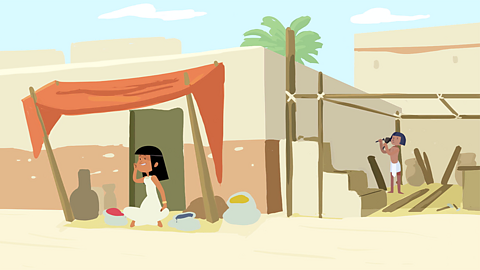How did the ancient Egyptian civilisation start?
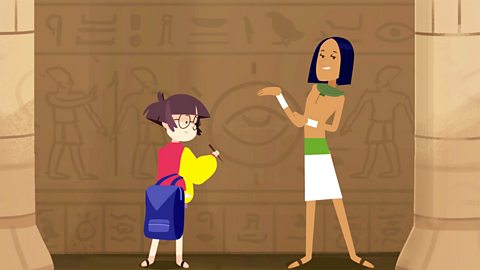
The ancient Egyptian civilisation began 5,000 years ago when people started building villages next to the River Nile in north-east Africa. It lasted for around 3,000 years.

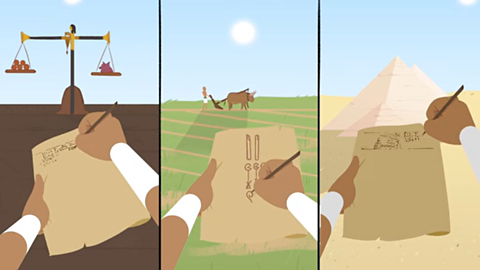
The river was an important source of water in a hot and dry desert landscape.
The ancient Egyptians were able to grow lots of crops like wheat, barley, fruit and vegetables. They also grew flax to make clothes and papyrus to make paper.
Watch: Introducing the ancient Egyptians
Child: The ancient Egyptian civilisation began 5,000 years ago and lasted 3,000 years!
It was located along the River Nile in north-east Africa. I better write this down!
Oh! I’ve lost my pen.
Ancient Egyptian: You’re clearly not Egyptian, are you?
Child: No, I’m from Britain.
Ancient Egyptian: Haha! No wonder you don’t have a pen. I’m surprised you even know what they are. We’re way ahead of anyone in Britain.
Stonehenge is nothing, compared to these!
Child: Woah!
Ancient Egyptian: What have you got in this linen sack thing anyway? Oh, a calendar! Now that is useful. It’s similar to our own solar calendar which has 365 days in it.
You do have bread at least!
We have some of the most efficient tools for making flour. And we use the River Nile to provide water for our crops. And you’re even using papyrus.
Child: It’s paper actually.
Ancient Egyptian: Well, whatever you call it, we invented it.
We use it to write down our language using small pictures called hieroglyphs.
It’s quite complex, so it takes a scribe like me to do it.
Child: Can you see my pen in there?
Ancient Egyptian: No, which is a shame as record keeping, organisation and planning are key to any successful civilisation.
All these things have helped us become one of the greatest civilisations in world history!
Child: Wow, it’s true what they say. The pen is mightier than the sword.
Ancient Egyptian: Swords have helped a little along the way…
What’s known about the ancient Egyptians?
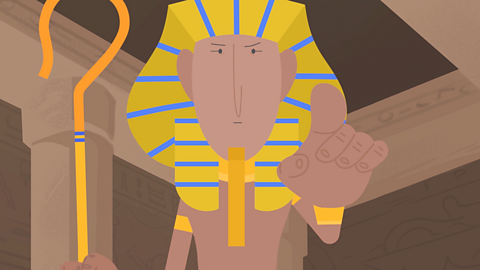
The ancient Egyptians were experts at farming and construction because they were very inventive.
They invented a solar calendar (a calendar based on the sun) and a writing system called hieroglyphs.
The ancient Egyptians were ruled by kings and queens were called pharaohs. Religion was an important part of their civilisation. They worshipped over 2,000 gods and goddesses!
The ancient Egyptians also believed in a never-ending afterlife. They thought it was more important than their life on Earth, so they spent a lot of time planning for their death.

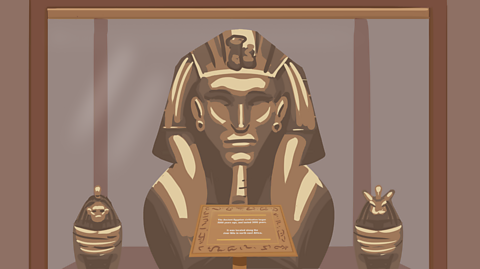
The ancient Egyptians preserved the bodies of important people through mummification. They built special tombs to be buried in, which they filled with all their favourite things. Some pharaohs built their tombs in the shape of giant pyramids.
What were the pyramids?
The pyramids are giant tombs. Each side is triangular, and they meet in a point at the top. The most famous is the Great Pyramid of Giza at 480 feet high made from 2.3 million large blocks.
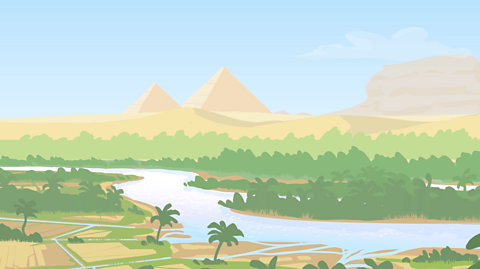
The Great Pyramid of Giza is around 4,600 years old. It was the tallest human-made structure in the world for 3,800 years.
After it was finished, it was covered in white limestone. There were three chambers and two entrances. However, the inside was looted (robbed) and nothing remains except for some large sarcophagi (coffins) of the early pharaohs.
The Great Pyramid was part of a group of pyramids outside Giza, which also included the Great Sphinx.
What was happening in Britain?

Activities
Activity 1: Explore ancient Egyptian artefacts
- Image source, The Trustees of the British Museum
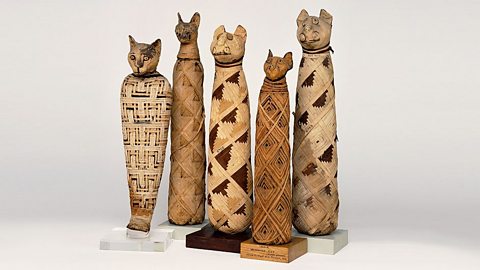
Image caption, Mummified cats
Ancient Egyptians thought cats were very special. They wanted to take their cats with them into the afterlife so they often mummified them and put them in their tombs.
- Image source, The Trustees of the British Museum
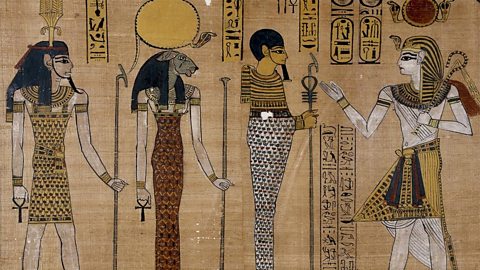
Image caption, The Great Harris Papyrus
This piece of papyrus (ancient Egyptian paper) shows Pharaoh Ramesses III standing in front of the three Gods of Memphis: Ptah, Sekhmet and Nfertum.
- Image source, The Trustees of the British Museum
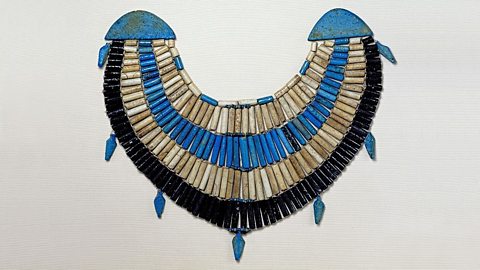
Image caption, Beaded collar necklace
Ancient Egyptians decorated themselves with as much jewellery as they could afford. This is a ceramic glazed wide collar necklace. The seven little blue beads hanging down are made in the shape of mummies.
- Image source, The Trustees of the British Museum

Image caption, Gold leaf mummy mask
This mummy mask is coated in gold leaf. It is a mask for a rich ancient Egyptian. This mask was put on top of a mummy's bandages to protect the head.
- Image source, The Trustees of the British Museum

Image caption, Shabti figure
This is a blue glazed shabti figure of a pharaoh called Sety I. A shabti is a little doll that ancient Egyptians would make and put in their tombs to keep them company when they died. They often had tools so that they could do work for people in the afterlife. This one is holding a farming tool called a hoe in each hand.
- Image source, Getty
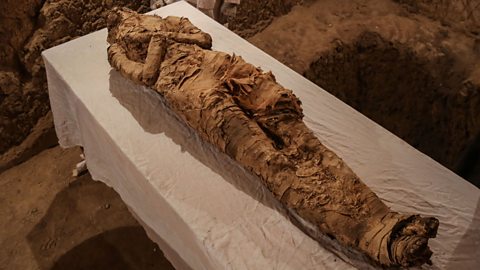
Image caption, Ancient mummy
This ancient mummified body was found in a tomb in Luxor. This is the real mummy of a pharaoh from around 1500BC.
- Image source, The Trustees of the British Museum
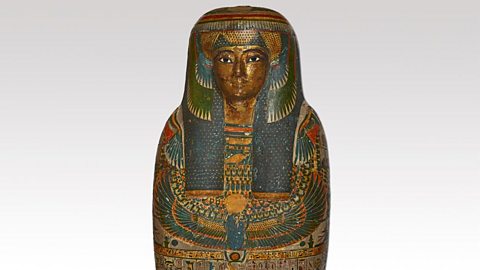
Image caption, Human mummy case
This is a painted cartonnage (mummy case) for a woman. It has a gilded face and a scarab beetle pendant. Scarab beetles were very important to ancient Egyptians - they symbolised the restoration of life.
- Image source, The Trustees of the British Museum
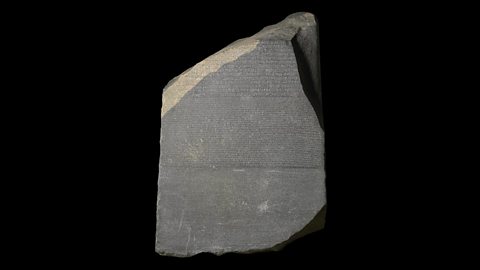
Image caption, The Rosetta Stone
This is the Rosetta Stone. It is made from granite and it has three sets of inscriptions carved into it: Demotic, Hieroglyphs and ancient Greek. The broken top and bottom edges suggest it was part of a much bigger piece of stone.
1 of 8
Activity 2: Quiz – Introduction to Ancient Egypt
Activity 3: Make your own pyramid treasure tomb
Make your own pyramid treasure tomb
Make your own pyramid treasure tomb. documentMake your own pyramid treasure tomb
Download our pyramid treasure tomb template. Follow our step-by-step guide to make your own pyramid. What secrets will you bury inside?

Activity 4: History Explorer game
Play this game to test your knowledge and learn even more facts about Ancient Egypt.
History Explorer: Secrets through time
History Explorer: Secrets through time: KS2 History
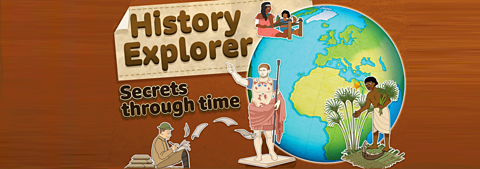
Teaching resources
There are more teaching resources available on BBC Teach. These short animated videos explore Ancient Egypt. There are five films devoted to key themes - such as the River Nile and Gods and goddesses.
BBC Teach has thousands of free, curriculum-linked resources to help deliver lessons - all arranged by subject and age group.
SAT’s preparation resources. activitySAT’s preparation resources
Get ready for the SATs papers with videos, activities, quizzes and games to refresh your knowledge and practise your skills.

More on Ancient Egypt
Find out more by working through a topic
- count2 of 18
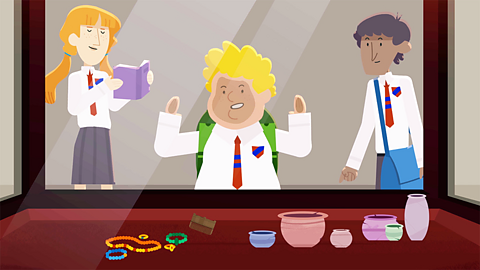
- count3 of 18
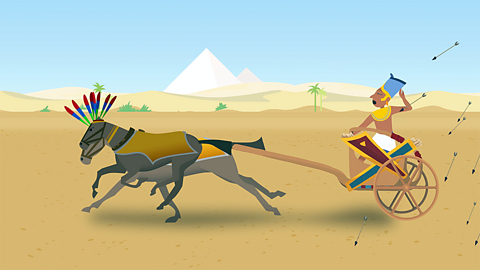
- count4 of 18
